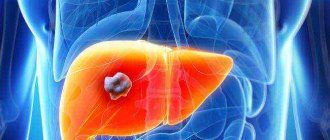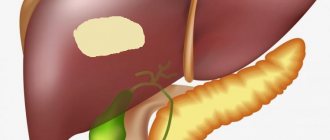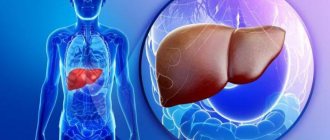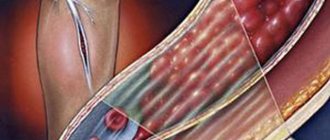Liver adenoma is a benign neoplasm that develops in blood vessels and epithelial tissue. The most common location for adenoma is the right lobe of the liver. The components of liver adenoma are atypical and normal hepatocytes.
The tumor can reach large sizes. Most often, the disease affects women aged from twenty to forty years. The ratio of adult men to women suffering from the disease is 1 to 4.
Causes of the disease
Liver adenoma is detected quite easily. This formation is located in a separate capsule. Its internal part has a heterogeneous structure. As a result, pain is felt during palpation. It is noted that the tumor can be single or multiple. This indicates the general state of the tumor process.
Medicine has not identified the exact causes that serve as causative agents for the formation of a tumor in the liver. However, scientists in this field have been able to identify factors influencing the appearance and development of the tumor process in this organ.
Classification of the international TNM system
Using the TNM grading system, you can assess the spread and stage of development of adenocarcinoma, select a treatment protocol and make a tentative prognosis in a particular case.
TNM classification consists of three main aspects:
T—primary tumor;
N – damage to lymph nodes;
M - distant metastases.
Let's see what it looks like in the following table.
| Stages | T | N | M |
| I | T1 | N0 | M0 |
| II | T2 | N0 | M0 |
| IIIA | T3 | N0 | M0 |
| IIIB | T any | N1 | M0 |
| IVA | T4 | M any | M0 |
| IVB | T any | N any | M1 |
Summary of the table:
T - primary tumor:
- T1 Solitary ⋜ 2 cm without vascular invasion.
- T2 Solitary ⋜ 2 cm with vascular invasion or >2 cm without vascular invasion.
Multiple ⋜ 2 cm without vascular invasion.
- T3 Solitary >2 cm with vascular invasion.
Multiple >2 cm with or without vascular invasion.
- T4 Multiple, both lobes of the liver are affected. Invasion of the portal and hepatic veins, neighboring organs and visceral tumor invasion into the peritoneum are noted.
N - regional lymph nodes:
- N0—no signs of metastatic lesions;
- N1 - there are lesions.
M - distant metastases:
- M0 - none;
- M1 - there are lesions.
Factors influencing the process of adenoma formation
Among them it is noted:
- Use of hormonal drugs. It has been established that a large percentage of women who used hormonal contraceptives most often suffer from liver adenoma. In males, this process occurs due to prolonged use of steroids.
- The influence of the environment, including background radiation, as a result of which tumors can arise in various organs, including the liver.
- Genetic inheritance. If one of the blood relatives suffered from the tumor process, the disease may arise due to genetic transmission at the cellular level.
- Improper nutrition can also become a causative agent of the inflammatory process, leading to the formation of a tumor. Eating too fatty foods for a long time, as well as a lack of fiber in the body, can cause various pathologies, including adenoma.
Description and statistics
The liver is one of the most important anatomical structures, which performs many functions necessary for normal human life. Therefore, cancer in this organ is always characterized by a severe course and a high risk of death.
A malignant tumor that provokes mutational changes in the glandular epithelium of the liver is called adenocarcinoma. It can be primary and secondary. The primary oncological process, that is, the emergence of atypical changes directly in the organ, occurs in 25% of cases. More often we are talking about secondary adenocarcinoma resulting from metastasis.
Malignant cells from other affected organs, most often the gastrointestinal tract, lungs and mammary glands, penetrate the liver by lymphogenous, hematogenous and invasive routes, that is, as a result of tumor germination from neighboring organs.
According to WHO statistics, the peak incidence of liver adenocarcinoma occurs in men over 40 years of age and in women after menopause.
ICD-10 code: C22 Malignant neoplasm of the liver.
Liver adenoma: symptoms
There are practically no characteristic signs and manifestations in the event of the disease occurring at an early stage. Severe symptoms of the tumor process are observed when the tumor begins to compress organs.
This process occurs due to the increased size of the tumor. In this case, the following symptoms may occur:
- Pale skin all over the body.
- Presence of excessive sensation of thirst.
- Increased sweating.
- The appearance of nausea.
- The occurrence of belching.
- A sharp drop in pressure.
- The appearance of discomfort in the liver area.
It is worth noting that the symptoms are of the most general nature, therefore they are similar to other diseases in this area. It is recommended that if any symptoms appear, you undergo a comprehensive examination in order to make a correct diagnosis.
Diagnostic procedures
When a patient approaches, the doctor conducts an initial medical history and general manifestations of the disease. Next, palpation of the abdominal cavity is performed. If the tumor has been developing for a long time, a primary diagnosis can already be made at this stage. To confirm, a biochemical analysis of urine and blood is performed, as well as an ultrasound examination of the abdominal organs. Using ultrasound, the specific location of the liver, its size, consistency and the presence of metastases are determined. Adenocarcinoma is diagnosed using the following methods:
- fluoroscopy;
- endoscopic examination;
- ultrasound diagnostics;
- various types of tomography.
Tests are performed for the presence of tumor markers. Additionally, the doctor may prescribe laparoscopy, positron emission tomography and angiography. If the diagnosis was made in the early stages of tumor development, there is a chance of a complete cure. If the patient has other forms of malignant tumors, he must undergo an ultrasound examination of the liver every 6 months to detect metastases.
Complications
Pathological reactions that occur in the absence or ineffective treatment process are dangerous for the patient. The most serious complication is the occurrence of liver cancer. In medicine, there are a number of signs indicating the occurrence of this disease:
- The process of tumor spread into the vascular system.
- The appearance of hemorrhages.
- Necrotic manifestations characteristic of this condition.
- Process of adenoma invasion.
- Increased level of bilirubin in the blood.
Liver cancer is a dangerous disease that threatens human life. Therefore, it is necessary to avoid any kind of complications during the treatment process.
Life expectancy at different stages
It is not easy to determine what the life expectancy of a person diagnosed with liver adenocarcinoma will be. Any forecast is only an average number calculated using statistics, so it is impossible to accurately say about the duration of remission for a particular patient. But it is important to understand that malignant liver disease is an aggressive process, so most often assumptions of this kind are disappointing.
Let us consider in the following table what the prognosis for five-year survival will be at different stages of this disease.
| Stages | Favorable prognosis |
| I | 85,00% |
| II | 50,00% |
| III | 25,00% |
| IV | 7,00% |
Diagnosis of the disease
Correct diagnosis is the most important step in the treatment process. It is characterized by identifying all the necessary information about the state of the tumor process in the liver. It is carried out exclusively under the supervision of specialists in this field.
This process involves the following activities:
- General survey about the patient's condition.
- General inspection.
- A blood test is ordered.
- An ultrasound of the liver is prescribed.
- An MRI is prescribed.
- An x-ray must be prescribed by a specialist.
- Passing elastography.
- Biopsy.
- Endoscopy.
It is worth noting that palpation is required during the diagnostic process. This process allows the specialist to determine the level of spread and condition of the tumor. With the help of palpation, it is possible to determine a benign or malignant area. A patient who is suspected of having a disease such as liver adenoma will definitely be sent for an ultrasound. An accurate and more detailed picture can only be provided by a complete comprehensive completion of all diagnostic procedures.
Diagnostics
Small adenomas are difficult to detect. First, the doctor studies the medical history, its symptoms, finds out whether the patient took hormones and for how long, how he eats, and studies his family history. Then he palpates the abdomen and conducts a visual examination.
When making diagnoses, the doctor prescribes several examination methods:
- Laboratory blood tests;
- Tumor markers;
- Ultrasound of the liver to detect a tumor and determine its size;
- MRI AND CT for a more detailed study of the tumor and organ;
- X-ray of the peritoneal organs;
- Pancreatocholangiography, which studies the condition of the bile ducts;
- Elastography to determine the elasticity of the organ;
- Biopsy of the tumor and further examination of the material.
Liver adenoma: treatment
It is carried out depending on the stage of tumor growth.
If the liver adenoma is less than a centimeter in size, the oncologist will discontinue the use of any hormonal drugs.
In conditions of transformation from a benign tumor to a malignant one, the following measures are applied:
- Waiting. This tactic is used after removal or elimination of the factor influencing the appearance of the tumor.
- If the adenoma grows, laparoscopic surgery is prescribed. This method is used only when the size of the adenoma is less than eight centimeters. In the case of opening the abdominal cavity with a large tumor size, there is a risk of severe consequences.
The treatment process for a disease such as liver adenoma is quite complex. It is focused on effective treatment mainly at an early stage. It is worth noting that this formation is subject to effective treatment in a benign form. A malignant tumor cannot be treated with medication. This formation can be removed surgically if the size is appropriate.
It is possible to treat liver adenoma with folk remedies. But this can only be done strictly after consulting a specialist. In the case of liver adenoma, treatment with folk remedies can be effective using nettle, rose hips, and wheatgrass root. For 10 days, decoctions based on mint, wormwood, fennel, yarrow, and celandine juice are also used.
Kinds
Experts define several classifications of adenomas depending on various factors. Based on the quantitative indicator, an adenoma can be either single or multiple, growing into several separate parts. The structure of the formation directly affects the severity of the disease, as well as possible consequences in the future. Doctors distinguish the following types of liver adenomas:
- hepatomas or hepatocellular adenoma;
- cholangioadenomas;
- Cystoadenomas.
Hepatomas are benign tumors. They grow from liver cells - hepatocytes. Most often, this type of adenoma occurs in males.
Glandular cells of the bile ducts located inside the liver can form halongioadenomas. In this case, tumor development occurs from epithelial tissue. In most cases, women are susceptible to this disease.
A separate type of halongioadenomas are cystoadenomas. They differ in that they are malignant tumors that have a liquid internal structure. Inside them are particles of cholesterol, bilirubin, and some other cells. In this case, there is a risk of death or long-term treatment with chemotherapy and radiation therapy.
There is also a classification of adenomas according to their component parts. In this case, specialists can distinguish tubular and trabecular forms of the disease. Trabecular adenoma is distinguished by the fact that its components are hepatic beams, which are similar to trabeculae. In a normal state, they are located radially and go from the center to the periphery of the organ, while in a tumor formation their localization occurs chaotically, they do not form lobules and their thickness is noticeably thicker. In this case, portal tracts and hepatic veins are absent.
Disease prevention
To protect yourself from pathologies, it is worth eliminating the possible causes of the disease as much as possible. First of all, people who are predisposed to this disease should monitor their diet and give up bad habits. Men should stop taking anabolic steroids, and women should limit hormonal contraceptives. It is recommended to eat as many fiber-rich foods as possible. If the first signs of illness appear, immediately contact a specialist.











